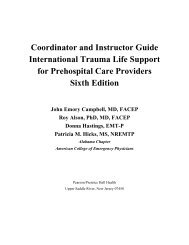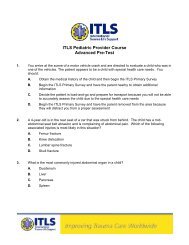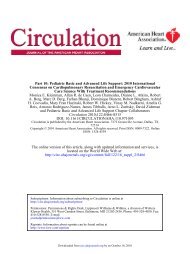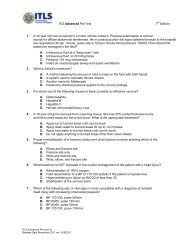The Fundamentals of Neonatal Resuscitation The Fundamentals of ...
The Fundamentals of Neonatal Resuscitation The Fundamentals of ...
The Fundamentals of Neonatal Resuscitation The Fundamentals of ...
Create successful ePaper yourself
Turn your PDF publications into a flip-book with our unique Google optimized e-Paper software.
9/17/2012<br />
<strong>The</strong> <strong>Fundamentals</strong> <strong>of</strong><br />
<strong>Neonatal</strong> <strong>Resuscitation</strong><br />
Kimberly Marcus BSN,RN<br />
REMSA Education Center RF,TF<br />
Newborn Period Defined<br />
• Ideally, newborn resuscitation takes<br />
place at birth or in the NICU setting.<br />
• Exact definition <strong>of</strong> the newborn<br />
period “ birth to 28 days <strong>of</strong> life “.<br />
• NRP vs. PALS <br />
Initial Basic Assessment<br />
• All newborns require initial assessment.<br />
• A basic assessment can be handled promptly and quickly<br />
with a few simple questions.<br />
• Is the baby term Amniotic fluid clear Baby breathing or<br />
crying Is there good muscle tone<br />
• Hx <br />
• Simultaneously….. basic newborn care (the infamous<br />
inverted triangle )<br />
• Provide warmth, position & open the airway, dry and<br />
stimulate to breath<br />
• Clear (if required )<br />
Make it simple on<br />
yourself<br />
• Don’t STRESS out! Only about 10% <strong>of</strong><br />
babies need further resuscitation<br />
• Okay we always get the other 10% so<br />
STRESS out!<br />
• <strong>The</strong> rest make it simple on yourself…<br />
decide – supplemental O2, assist vent <br />
• And it is always good to stay up on your<br />
NRP class<br />
Time Frame<br />
• Remember everything in NRP is ideally<br />
based on assessment, treat the<br />
assessment, reevaluate the treatment<br />
• <strong>The</strong> time frame is all done in blocks <strong>of</strong> 30<br />
seconds<br />
• Give yourself the full time especially when<br />
ventilating a baby<br />
<strong>The</strong> Bottom Line<br />
• If you have a newborn that is Term, hx, breathing<br />
or crying, with good tone ….GREAT routine<br />
newborn care!<br />
• Remember even with meconium if vigorous only<br />
clear oro/nasal if need and give routine care.<br />
• Vigorous/Non-vigorous <br />
• Continue ongoing evals<br />
• We will discuss the further needs babies in the<br />
ABC’s<br />
1
9/17/2012<br />
Basic Airway<br />
• Ideally the term newborn needs to initiate a smooth<br />
transition out <strong>of</strong> utero and make quick effective first<br />
breaths.<br />
• Thus some <strong>of</strong> the changes in 2010 to help decrease delay <strong>of</strong><br />
breaths.<br />
• Or the newborn needs to be effectively breathing on his<br />
own.<br />
• So ask yourself Are they breathing, crying, moving,<br />
meconium but vigorous<br />
• <strong>The</strong>n you can do simple basic airway management<br />
Airway Management<br />
• Support the head<br />
• Open the airway by positioning the<br />
newborn<br />
• Positioning….<br />
• Clear the airway if needed<br />
• Meconium vigorous<br />
• Do not delay …..WARM & DRY<br />
Meconium<br />
• Vigorous/Non vigorous<br />
• Non vigorous suction trachea before<br />
other resuscitation steps<br />
• HR dictates time <strong>of</strong> suction<br />
• Clear proceed<br />
• Remember 30 second blocks!<br />
Breathing<br />
• <strong>The</strong> baby effectively breathing on<br />
his own is the key to transition<br />
• Thus “adequate ventilation” <strong>of</strong> the<br />
baby’s lungs is the MOST important<br />
and effective action in neonatal<br />
resuscitation<br />
<strong>The</strong> Good<br />
Sooooo…..<br />
Breathing<br />
<strong>The</strong> Good<br />
Warm & Dry<br />
Airway Open<br />
2
9/17/2012<br />
<strong>The</strong> Bad<br />
<strong>The</strong> Bad<br />
HR >100<br />
Warm & Dry<br />
BUT<br />
• Labored<br />
breathing<br />
• Cyanotic<br />
• GIVE SUPP O2<br />
HR
9/17/2012<br />
Ratio<br />
• 3:1 with effective ventilation<br />
• Repeat “ One and Two and Three and<br />
BREATHE” over 2 seconds<br />
• 120 “events” p/min<br />
• Anticipate… remember that hx<br />
Drugs<br />
• Despite 30 seconds <strong>of</strong> effective ppv, & 30<br />
seconds <strong>of</strong> chest compressions, and the<br />
HR < 60<br />
• EPI<br />
• 0.1mL/kg -0.3mL/kg IV<br />
• Remember that Hx<br />
• Isotonic crystalloid 10mL/kg over 5-10 min<br />
2010 NRP Major<br />
Recommendation Updates<br />
• Progression to the next step after the initial eval is now<br />
based on 2 vital characteristics .. HR & RESPIRATIONS<br />
• Titrate oxygen with oximetry color subjective<br />
• Babies born at term best to begin resuscitation with RA and<br />
move forward.<br />
• Admin <strong>of</strong> supplemental O2 should be blended if capable<br />
• Research does not support or refute routine sxn<br />
• Chest compression-vent ratio 3:1 unless known cardiac origin<br />
• Consideration <strong>of</strong> therapeutic hypothermia for term/near<br />
term infants with moderate to severe hypoxic ischemic<br />
encephalopathy<br />
4







